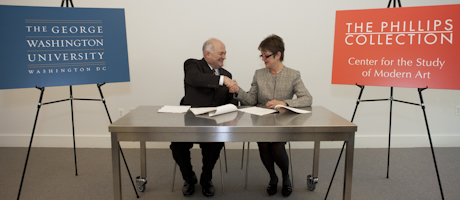Nov. 7, 2010
GW has forged a new partnership with America’s first museum of modern art.
The Phillips Collection, one of the world’s most distinguished collections of impressionist and modern American and European art, has partnered with GW to jointly organize art history courses, artist visits, post-doctoral fellowships and an internship program, all at both GW and the Phillips’s Center for the Study of Modern Art.
“In joining forces with the George Washington University, the Phillips gains as its valued partner D.C.’s largest institution of higher learning,” said Phillips Director Dorothy Kosinski. “The Phillips is thrilled to count such a well-respected and globally connected Washington institution among its creative collaborators.”
On Nov. 5, Ms. Kosinski and GW President Steven Knapp signed a memorandum of understanding at the Phillips detailing the agreement between the two institutions over the next three years, which begins with a course titled “The Performative Impulse in American Art,” taught by GW professor Virginia B. Spivey.
Other GW administrators in attendance at the signing ceremony included Provost and Executive Vice President for Academic Affairs Steven Lerman; Deputy General Counsel Charles K. Barber; Vice President for Research Leo M. Chalupa; Dean Kessmann, chair of GW’s department of fine arts and art history; Peg Barratt, dean of the Columbian College of Arts and Sciences; and Michael Feuer, dean of GW's Graduate School of Education and Human Development.
Under the agreement, the two institutions will also co-sponsor a “Conversations with Artists” series. The first installment features several artists, including John Simon Jr., Jim Sanborn and Alice Aycock, as they explore the theme “Systems of Knowledge.” The artists will also visit the GW campus, where they will interact with students and faculty. In early 2011, the Phillips and GW will award two post-doctoral fellowships to support emerging scholars and facilitate teaching and research on modern and contemporary art.
“This new partnership with one of Washington’s preeminent arts institutions creates exceptional teaching, internship and research opportunities for George Washington students and faculty,” said Dr. Knapp.
Danielle O’Steen, a graduate student in art history, took advantage of the new partnership by enrolling in Ms. Spivey’s graduate seminar, and next year will be coordinating the second annual Graduate Student Roundtables at the Center for the Study of Modern Art.
“The collaboration with the Phillips gives GW students more resources at their disposal,” said Ms. O’Steen. “It creates a bridge between the university and a museum of high acclaim, offering a rare opportunity for both students still pursuing a degree and those looking to develop their career.”
Calling the Phillips a “valuable resource,” Mr. Kessmann said the department is “extremely excited” to be both co-sponsoring the Conversations with Artists lecture series and facilitating interaction between visiting artists and GW students.
“Faculty members across the department recognize the importance of having students in front of actual works of art, in addition to viewing projected images in a lecture hall,” he said. “We often tell incoming students that we view the local museums as extensions of our classrooms; it is one of the huge benefits of studying art at an urban campus in Washington, D.C.”
The Phillips’s Center for the Study of Modern Art also hosts events of the Contemporary Art Think Tank (CATT), which was founded by Assistant Professor of Art History Alexander Dumbadze. Mr. Kessmann said CATT has been “incredibly valuable” to the intellectual life of the department and city, in that it brings together art historians, curators, critics, and students to discuss a wide variety of concerns in contemporary art.
Emilie Kretschmar, M.A.’09, worked as a museum supervisor at the Phillips before she began her coursework in art history at GW and said the opportunity “added depth” to her educational experience.
“As any art historian will tell you, it is absolutely essential to experience and connect with art in person,” said Ms. Kretschmar, who now works in development at the Historical Society of Pennsylvania. “Not every institution of higher education is fortunate to have such a wonderful collection within walking distance, and I think this is a real opportunity for GW students to get inspired, make deeper connections between art theory and art itself, and learn from real working museum professionals.
“Working at the Phillips Collection provided an important real-life experience--taking knowledge from the classroom and contextualizing it in a working world-renowned museum,” she added.


